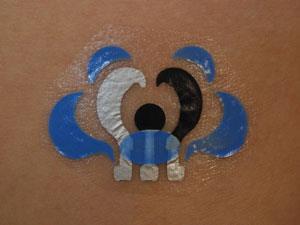
Joseph Wang and his colleagues from the University of California, San Diego, have combined their expertise in printing flexible chemical sensors with commercially-available temporary tattoo paper. Integrating the electrochemical sensor within T3 maximises its contact with skin, including all epidermal irregularities, thanks to the elasticity of the T3 material. In addition to this, the team dispersed carbon fibre (CF) segments into the tattoo ink, providing an interlinked conductive backbone that enhances the sensor’s electrochemical behaviour. The CF constituents also help to counteract cracking and provide the mechanical reinforcement needed to protect the sensor against routine wear-and-tear while on the skin. The team also showed that the T3 sensor (on pig skin) could be used for detecting explosives like 2,4,6-trinitrotoluene (TNT), in connection with square wave voltammetry.
Wang explains that ‘future challenges for “electronic skin” sensing devices include the integration of these tattoo-based electrochemical epidermal sensors with wearable electronics and identifying target bioanalytes for obtaining clinically relevant information’. Wang adds that ‘detecting agents of environmental or security relevance may be less challenging. The former, however, requires proper identification of clinically relevant target analytes, such as various metabolites or electrolytes, in the sweat’.
John Rogers from the University of Illinois at Urbana-Champaign, in the US, recently reported the use of temporary tattoos for measuring hydration levels in athletes. He says: ‘This is a very nice piece of work that exploits electrochemical sensor materials in skin-mounted “epidermal” formats. The result is a creative contribution to an emerging field of technology that involves devices that integrate onto the skin like temporary transfer tattoos.’
Image credit: Joseph Wang/University of California San Diego
References
- J R Windmiller et al, Chem. Commun., 2012, DOI: 10.1039/c2cc32839a






No comments yet